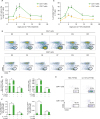INTRODUCTION
MATERIALS AND METHODS
Animals
Preparation and treatment
Virus infection
Flow cytometry
Bronchoalveolar lavage fluid (BALF) collection and lung homogenate preparation
RESULTS AND DISCUSSION
 | Figure 1Effect of FTY720 treatment on the expansion of pulmonary TRM-like cells following the intranasal introduction of IL-7-mFc. Mice (BALB/c, n=6) in each group were treated with PBS or IL-7-mFc i.n. (A-C) Pulmonary CD4 and CD8 T cells were analyzed for the level of CD62L and CD44 at each indicated time point after IL-7-mFc treatment. The number of CD4 and CD8 T cells in the lung (A) and CD62LloCD44high population in each T cell population (B, C) are shown as representative plots and graphs, respectively. (D-F) Mice were treated with IL-7-mFc i.n., and at the same time, they were also treated twice with 60 μg of FTY720 i.p. at 3-day intervals. The absolute number of total pulmonary CD4 and CD8 T cells (D) and the CD62LloCD44high population (F) in each T cell population were analyzed 6 day post-IL-7-mFc treatment. (E) Representative plots for TRM-like cells in the lung are shown. The data are representative of 2 independent experiments and expressed as the mean±standard error of mean.
*p<0.05, **p<0.01 by Student's t-test.
|
 | Figure 2Effect of FTY720 treatment on IL-7-mFc-mediated protection against IAV. (A) Mice (BALB/c, n=6) in each group were treated with PBS or IL-7-mFc i.n. At the same time, some mice were also treated twice with 60 μg of FTY720 at 3-day intervals. Mice were challenged with a lethal dose of H5N2 6 day post-IL-7-mFc treatment. Survival rates are shown. The data are representative of 2 independent experiments. (B) Mice were treated as described in (A) and treated with 200 μg of anti-CD4 mAb at −1, 0, 1, and 3 day post-challenge. The data are representative of 2 independent experiments.
**p<0.01 by log-rank test compared with PBS controls, ††p<0.01 by log-rank test comparing the IL-7-mFc and FTY720 groups.
|
Table 1
Intranasal administration of IL-7-mFc induces expansion of innate immune cells at the lung

 | Figure 3Role of pDCs in IL-7-mFc-mediated protection against IAV. Mice (BALB/c, n=6) were treated with 200 μg of anti-PDCA-1, anti-CD4 antibody, or IgG control (D-1, D0, D4, D7) after IL-7-mFc treatment and challenge. (A-C) Representative plots and absolute number of pDCs and other myeloid cells in the lung of IL-7-mFc-treated mice measured 9 dpi. (D) Mice were challenged with a lethal dose of H5N2. Weight and survival of the mice were monitored daily. Absolute number of neutrophils (E) in the lung of IL-7-mFc treated mice and inflammatory cytokines and chemokines (F) at 9 dpi were also measured in the BALF. (G) Antigen-specific CD8+ T cell response was assessed by intracellular cytokine staining of IFNγ after HA529–543 stimulation. Results are representative of 2 independent experiment and expressed as the mean±standard error of mean.
*p<0.05, **p<0.01, ***p<0.001; ††p<0.01 by log-rank test.
|




 PDF
PDF ePub
ePub Citation
Citation Print
Print


 XML Download
XML Download